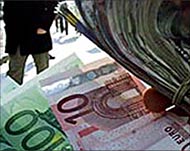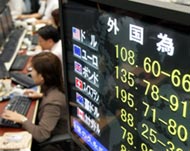Instability looms as currencies slide
Economic instability looms as major currencies seem to be racing each other to the bottom of the pile. This is the flavour of the markets at the moment. All topped off with a sprinkling of light sweet crude oil.

The release of the International Energy Agency’s (IEA) World Energy Outlook and the slump in the value of the US dollar are yet more factors destabilising markets.
Many commentators have talked of the possibility of the dollar falling sharply, most likely after a post-election rally, or even without one.
No less than Citibank thinks the dollar will fall further from its already low rate of $1.27 to the euro. Their most recent forecasts have the dollar falling to around $1.30 in one month then down to $1.33 within three months.
This week has seen the dollar hit six month lows against the euro and eight year lows against so called safe haven currencies such as the Swiss franc.
US economy weak
Why? Underlying the weakness of the US economy is its failure to stimulate real cash profits. The much cited growth of 2003/04 has been because of government spending, tax cuts, the selling of consumer/business debt and corporate profit taking from lay-offs and production increases.
|
“[The IEA report that says $592bn of investment is needed yearly to meet global demand for oil] is incredible with a capital I. It’s frightening” Bruce Evers, |
Often production increases really mean longer hours and less benefits for employees. Much of these arrived in the recession of 2000/2001.
With such insignificant margins, the rise in oil and energy costs has further dampened the core of the global economy – the US consumer.
The de facto effective US central bank, the Federal Reserve, has allowed the dollar to fall dramatically against foreign currencies.
They hoped this would boost exports and open up foreign investment. This did hold the US economy together for a while, but these measures are generally seen as unsustainable.
Instead the hoped-for kick start in the global economy has only been for the most refined industries. Energy, banking, arms and governments have all benefited in either profits or in the case of governments, spending power.
Expecting dollar’s fall
The fall in the US dollar, while expected, will place huge stress on other major currencies to devalue as well.
 |
|
The euro, holding strong against |
The Eurozone is already experiencing major structural difficulties. While it has been unable to stimulate demand among its citizens, it has relied on those quitting the dollar to bolster its currency.
It has held interest rates at 2% while American and British rates have risen. Yet that very bolstering means that its exports, central to Europe’s economies, rise in price and it becomes even less competitive.
It may create demands for European Central bank chief Jean Claude Trichet to introduce interest rate cuts to try to boost European demand.
Roger Nightingale from Saracin Chiswell in London said: “Trichet, the poor chap, has got things consistently wrong in the period since he took office and is now coming under intense political pressure to make amends.
“If German unemployment should continue to quicken its rate of increase and if joblessness in the sclerotic heart of Euroland were to continue to accelerate, there is not much doubt that Trichet would bow to the inevitable cutting rates hard and fast.”
Profitless US
Japan has always made no secret that it subsidises the US economy by propping up the dollar. The Japanese banks do this in order that US consumers can continue to buy affordable Japanese exports.
 |
|
Japan subsidises the US economy |
Also, Japanese companies can increasingly invest in a cheaper US. But as foreigners flee a profitless America, any dollar fall will set the euro against the yen.
Whose currency can remain competitive? Whose currency can attract foreign investment to introduce cash, or liquidity, into their national arena?
So we have a combination of high energy costs, slowing demand from China, a lack of profits in the US and a faltering Europe.
This could mean that major currencies will race each other to the bottom of the pile to stay ahead of each other. At the moment it is the euro and the dollar that look the most overvalued but the yen will also be pressured against both.
“It is not beyond the bounds of probability to suppose that 12 months hence [interest rates] in much of the financially sophisticated world might be hovering around zero,” says Nightingale.
Scary energy outlook
Rising energy costs are also throwing a huge spanner in the works. The IEA report World Energy Outlook believes there will be a staggering 59% increase in demand by 2030.
It says this requires investment of about $592 billion each year until then, or a total of $16 trillion.
Such predictions make the markets shudder.
|
“It is not beyond the bounds of probability to suppose that twelve months hence [interest rates] in much of the financially sophisticated world might be hovering around zero” Roger Nightingale, |
For a start how much energy do you use trying to build an extra $592 billion worth of supply? IEA director Claude Mandil said it would be “a considerable challenge”.
“It [the report] is incredible with a capital ‘I’,” Bruce Evers of Investec London told
Aljazeera.net. “The super majors can get to around $50 billion of investment, but these are figures 10 times that amount. It’s frightening.”
Mandil says the central message remains optimistic. But it is hard to see where he finds his optimism.
He says: “The Earth contains more than enough energy resources to meet demand for many decades to come”, yet part way through the report the IEA demands that oil-producing nations and companies create more transparency over oil reserve figures.
Up Everest
It says the world needs “a detailed analysis of how oil and gas companies calculate their proven, probable and possible reserves and a comparison of current estimates”.
The report goes on to say that “current practices vary considerably among companies, confusing the overall reserves picture”.
Yet Mandil has already claimed there are “more than enough energy resources”. Which one is the truth? Because the report also says there is a need “for more vigorous action to steer the global energy system on to a more sustainable path”.
“This [projected increase] is a huge amount of oil,” Evers says. “They would have a lot of fun looking. You would end up halfway up Mount Everest trying to find it. The North Sea would be long gone, so would the Gulf of Mexico. Long gone.”
It appears the World Energy Outlook raises more questions than answers. In the current climate of jobless recoveries, depreciating currencies, record levels of citizen debt and widespread political violence, more questions is not what is needed.